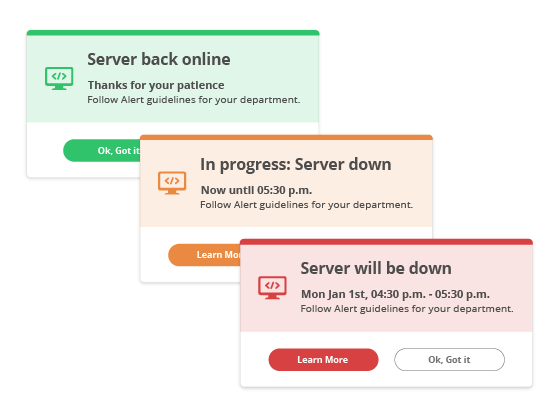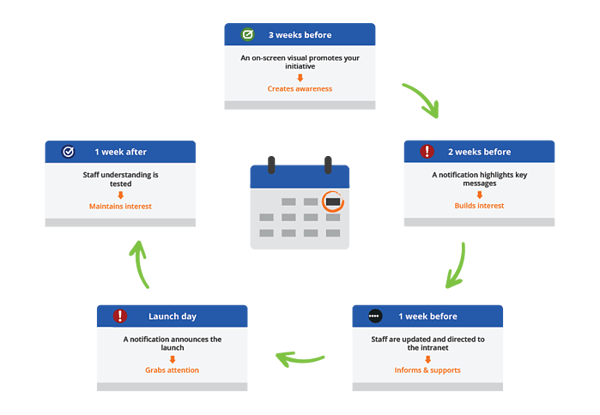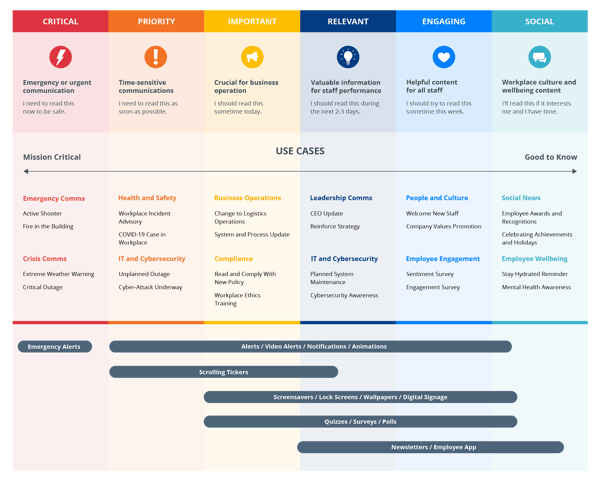
Picture this: Your company is introducing a new tool for employees to use, and you’ve prepared a big launch for it…
…but no-one’s engaged. They’re not listening – they’re thinking of what they’re going to eat for lunch. They’re not reading your email – they’ll get to it later, or tomorrow, or Monday, maybe.
Sound familiar?
We’ve all been there. Unread messages and overlooked information are the bane of Human Resources and Communications teams. But what can we do about it? How can we improve message success?
Below we’ll prescribe 10 internal communication tips to cure any case of ineffective messaging. The internal comms doctor is in!
1. Keep Consistent Representation
Use the same style, branding and tone throughout all your messages. Consistency increases cut-through and readership. Research shows that messages presented consistently are up to 4 times more likely to be recognized by staff.
A good example is Microsoft Teams. New message notifications are always presented at the bottom right of screen. They’re always the same color, structure and style. Staff immediately recognize it and know what to expect – which increases employee engagement.

2. Target the Right Audience
Staff are too busy for irrelevant messaging. Sending ‘all staff’ emails where the content is only relevant to a small group is a recipe for employees hitting the delete key.
Targeting messages increases relevance. Set your employees up as groups based on their role, location, systems used and so on. You can then send them targeted messages you know they will read.
Here’s a real world example of where effective targeting had a big impact on comms success.
3. Use Visual Cues
Colors, icons and symbols help people consume information faster. Think of the road signs you see while driving. They pack a lot of information in – but we understand it instantly.
Using visual cues in employee messaging could include a dedicated color scheme for all HR content, or a padlock icon for all cyber security messages.
In the example below, we’re using a traffic light system for IT outage notifications. In our pop-up Desktop Alerts, we use red when there’s an outage, orange when it’s being worked on, and green when it’s resolved.

4. Repeat Until Read
It’s common for employees to miss messages first time. They intend to come back to read it… but never do. Setting up recurrence of important messages boosts readership.
Getting the cadence of repeating your messages right is essential. A shorter time between recurrence means higher impact, which drives faster action – but risks disengaging your audience. Set time between initial send and each repeat appropriate to message urgency.
5. Use Design and Movement
Dynamic messages are more appealing – and essential if we need to grab employee attention. This works because as humans we’re conditioned to see movement.
Include animation, videos or scrolls in your content where appropriate. You needn’t go overboard though – a subtle animation or fun gif can work wonders in encouraging staff to read more.

6. Keep it Brief
Brevity is one of the key employee communication tips. Employees will read only part of longer messages – anything beyond that point is ignored.
One idea per message is a good rule of thumb. Remember most of your employees are used to the ‘short and snappy’ style of social media. Improve communication by keeping word counts to a minimum, and don’t forget to include a call to action (that is, what you want staff to do next).
7. Optimize Screen Space
Set your messages to display differently for different messages. Position on the screen, as trivial as it sounds, can improve cut-through. It conditions employees to expect certain types of content when messages appear in different places.
For example, at SnapComms we use the upper right corner of the screen for operational messages. The lower left corner is for HR messaging. Critical or time-sensitive communications are larger and centered on screen.

8. Bring Communication to Life
Keep your audience in mind when you’re creating content. Consider what’s in it for them. Why should they read this?
Make messages more interesting by writing more informally, using imagery, and making the titles or subject lines ‘grabby’.
Creating personas for each of your audience groups is a great way to better understand them – which will help you create more effective messages.
9. Take a Campaign Approach
Communicating is never one and done. Reinforcement of key messages is essential so they are read, understood and acted upon.
Communication campaigns achieve this by focusing on frequency and format. Higher message frequency builds awareness. Diverse message formats improve understanding and drive outcomes.

10. Follow the Communications Spectrum
Sending every message through the same channel is a common communication mistake. Some channels are better suited to certain content than others.
Align your message content with the optimal channel using the Communication Spectrum. By using this framework, you’ll see how to achieve high comms cut-through by sending the right content, through the right channel, using the right format.

Internal communications are essential for business success in the post-pandemic world. By improving how you create and deliver content, you’ll ensure your messages reach employees every time.
The SnapComms platform offers the full suite of communication channels, from high-impact alerts to engaging questionnaires. Speak with us to find out how we can help you with your internal communication strategy.



